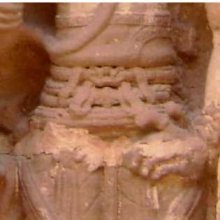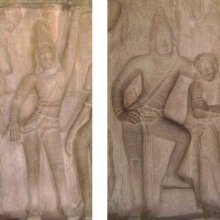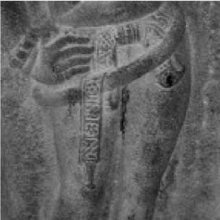Katibandha, Kaṭibandha, Kati-bandha, Katibamdha: 9 definitions
Introduction:
Katibandha means something in Hinduism, Sanskrit, the history of ancient India, Marathi. If you want to know the exact meaning, history, etymology or English translation of this term then check out the descriptions on this page. Add your comment or reference to a book if you want to contribute to this summary article.
Images (photo gallery)
(+6 more images available)
In Hinduism
Shilpashastra (iconography)
Source: Google Books: Elements of Hindu iconographyThe belt going round the hip is called Kaṭibandha (कटिबन्ध).
Source: Shodhganga: Vaisnava Agamas And Visnu ImagesKaṭibandha (कटिबन्ध) refers to a type of “decorative band” (bandha), as defined in treatises such as the Pāñcarātra, Pādmasaṃhitā and Vaikhānasa-āgamas, extensively dealing with the technical features of temple art, iconography and architecture in Vaishnavism.—Kaṭisūtra is a (simple or thin) thread worn around the waist. Sometimes it is beautified with pearls or gems. Kaṭibandha is a band or belt worn over the waist. It is supposed to hold the under-garment/robe, which is then tied or wrapped around it.

Shilpashastra (शिल्पशास्त्र, śilpaśāstra) represents the ancient Indian science (shastra) of creative arts (shilpa) such as sculpture, iconography and painting. Closely related to Vastushastra (architecture), they often share the same literature.
Shaktism (Shakta philosophy)
Source: Google Books: ManthanabhairavatantramKaṭibandha (कटिबन्ध) refers to a “(decorative) belt”, according to the Manthānabhairavatantra, a vast sprawling work that belongs to a corpus of Tantric texts concerned with the worship of the goddess Kubjikā.—Accordingly, “(Kubjikā) is the colour of (dark) blue collyrium. [...] (The snake) Ananta is said to be the anklet of her feet. Karkoṭa around (her) waist is said to be (her) belt [i.e., kaṭibandha]. Takṣaka is the sacred thread and the necklace around (her) neck is Vāsuki. Kulika, adorned with tortoise earrings, is said to be on (her) ears. Padma and Mahāpadma are on the middle of (her) eyebrows. Thousands of snakes adorn all (her) arms. (She is) adorned with a garland of flames (that surrounds her) and she shines like thousands of lightning flashes. Such is the venerable Kubjikā’s form. One should think of it as such until it is complete”.

Shakta (शाक्त, śākta) or Shaktism (śāktism) represents a tradition of Hinduism where the Goddess (Devi) is revered and worshipped. Shakta literature includes a range of scriptures, including various Agamas and Tantras, although its roots may be traced back to the Vedas.
India history and geography
Source: What is India: Inscriptions of the VākāṭakasKaṭibandha (कटिबन्ध) refers to a “band that ties together a pair of shorts”, during the reign of the Vākāṭakas (mid-3rd century CE).—Ajaṇṭā paintings give us a clear idea of the costume and jewellery worn by men and women in Vidarbha in the age of the Vākāṭakas. Most of them are shown dressed in a short antarīyaka or lower garment. As it did not cover the knees, it was called ardhoruka. [...] Women also wore their lower garment in a similar fashion. This is clear from one end of it dangling behind when they are shown seated or standing with the back turned towards others. Some women, however, wore their lower garment in the vikaccha fashion i.e. without the ends of it being tucked up behind. Some men wore a pair of shorts which were tied with a band called kaṭibandha. This kind of lower garment was called caṇḍātaka. From the Harṣacarita we learn that women also used to wear such a caṇḍātaka or underwear inside a long robe or kañcuka.

The history of India traces the identification of countries, villages, towns and other regions of India, as well as mythology, zoology, royal dynasties, rulers, tribes, local festivities and traditions and regional languages. Ancient India enjoyed religious freedom and encourages the path of Dharma, a concept common to Buddhism, Hinduism, and Jainism.
Languages of India and abroad
Marathi-English dictionary
Source: DDSA: The Molesworth Marathi and English Dictionarykaṭibandha (कटिबंध).—m (S) pop. kaṭibanda m A girdle, cincture, zone. 2 A zone of the earth.
--- OR ---
kaṭibandha (कटिबंध).—m (S) pop. kaṭibanda m kaṭibandhakavitā f A species of metrical composition,--that in which antithesis, alliteration, rhyme, and other verbal ornaments abound: also a piece of such composition.
Source: DDSA: The Aryabhusan school dictionary, Marathi-Englishkaṭibandha (कटिबंध).—m Agirdle. A zone of the earth. Species of metrical composition.
Marathi is an Indo-European language having over 70 million native speakers people in (predominantly) Maharashtra India. Marathi, like many other Indo-Aryan languages, evolved from early forms of Prakrit, which itself is a subset of Sanskrit, one of the most ancient languages of the world.
Sanskrit dictionary
Source: Cologne Digital Sanskrit Dictionaries: Monier-Williams Sanskrit-English DictionaryKaṭibandha (कटिबन्ध):—[=kaṭi-bandha] [from kaṭi > kaṭ] m. a zone, girdle, [cf. Lexicographers, esp. such as amarasiṃha, halāyudha, hemacandra, etc.]
[Sanskrit to German]
Sanskrit, also spelled संस्कृतम् (saṃskṛtam), is an ancient language of India commonly seen as the grandmother of the Indo-European language family (even English!). Closely allied with Prakrit and Pali, Sanskrit is more exhaustive in both grammar and terms and has the most extensive collection of literature in the world, greatly surpassing its sister-languages Greek and Latin.
Kannada-English dictionary
Source: Alar: Kannada-English corpusKaṭibaṃdha (ಕಟಿಬಂಧ):—
1) [noun] a waist band; a belt; a thread for the waist.
2) [noun] any of the five great latitudinal divisions of the earth’s surface, divided based on the prevailing climate.
Kannada is a Dravidian language (as opposed to the Indo-European language family) mainly spoken in the southwestern region of India.
See also (Relevant definitions)
Partial matches: Bandha, Kati.
Starts with: Katibandhana.
Ends with: Atiushna-katibandha, Samashitoshna-katibandha, Samashitoshnakatibandha, Shita-katibandha, Shitakatibandha, Udbhijjakatibandha, Ushna-katibandha.
Full-text: Samashitoshna, Ushna-katibandha, Ushna, Samshitoshn, Samashitoshna-katibandha, Samshitoshna-katibandh, Ushn, Sheet, Katava, Katisutra, Katavani, Sutra, Bandha, Sita, Kancuka, Vikaccha, Candataka.
Relevant text
Search found 4 books and stories containing Katibandha, Kati-bandha, Kaṭi-bandha, Katibamdha, Kaṭibaṃdha, Kaṭibandha; (plurals include: Katibandhas, bandhas, Katibamdhas, Kaṭibaṃdhas, Kaṭibandhas). You can also click to the full overview containing English textual excerpts. Below are direct links for the most relevant articles:
Pallava period (Social and Cultural History) (by S. Krishnamurthy)
Waist-band (Kati-sutra) < [Chapter 4 - Material Culture of the People]
Dressing style of Upper-class men < [Chapter 4 - Material Culture of the People]
Dressing style of Men < [Chapter 4 - Material Culture of the People]
Temples of Munnur (Historical Study) (by R. Muthuraman)
Sripura (Archaeological Survey) (by Bikash Chandra Pradhan)
Scultures of Ratnapani < [Chapter 3 - Sculptural Programme]
Cosmetics, Costumes and Ornaments in Ancient India (by Remadevi. O.)
2.7. Various other Waist Ornaments < [Chapter 3 - Ornaments]





